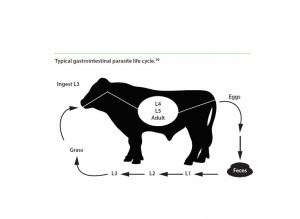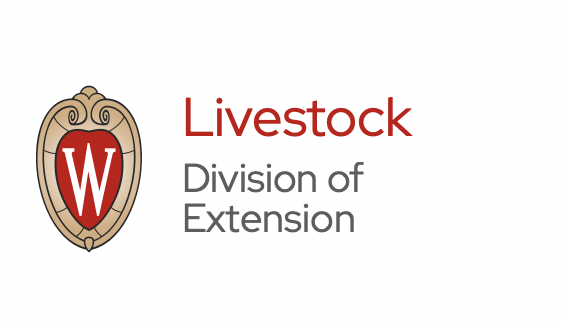Source: University of Wisconsin, Sandra Stuttgen
Parasitic worms of cattle include the nematodes Ostertagia, Cooperia, and Haemonchus. The worm’s life cycle occurs within cattle and on grass. Worm reproduction occurs within cattle intestines. Eggs and the first two larval stages are found in feces. The third infective stage (L3) resides on grass, and the last two larval stages and adult worms are found inside the animal. One female worm may produce tens of thousands of eggs.

Temperature, moisture, and grass management profoundly influence the population of the infective L3s. Infestation is highest during spring and fall when precipitation is plentiful, temperatures are moderate, and grass if rapidly growing. During such times, 99% of the total worm population is found on grass. Pastures are not treated to kill these larvae. Current deworming products are administered to cattle to kill the intestinal larval stages.
During hot and dry times of the year, much of the worm population resides inside cattle and can re-infest pastures when environmental conditions improve. For example, Ostertagia will ‘hibernate’ within the animal’s gut in a state of hypobiosis during times of suboptimal grass conditions. L3 themselves do not feed; they need to be consumed so that their life cycle continues inside the animal. Hot and dry pasture conditions will dry them out and speed their consumption of body reserves.
Talk with your veterinarian and/or nutritionist about deworming cattle during hot, dry weather when worm populations are likely to be high inside the animal. A fecal egg count (FEC) of 20 animals or 20% of the herd (whichever is greater) can provide an indication of overall worm burden. After deworming, a fecal egg count reduction test (FECRT) should be used to gauge the treatment’s efficacy; less than 90% reduction indicates worm resistance. Typically, the FECRT compares pre-treatment FEC to a 14-day post treatment FEC. A minimum of six but preferably ten to fifteen animals should be sampled for FECRT. Research indicates its better to compare pre- and post-FEC on individual animals rather than pooling the samples. With evidence of resistance, lab identification of the surviving worms becomes critical for managing them.
L3 are present when temperatures and rainfall support actively growing grass. Infective L3 remain close to the soil surface where moisture levels are more consistent. As a rule of thumb, when weather conditions support a morning dew, larvae are up on the grass waiting to be ingested. Four inches is considered the maximum vertical height larvae can achieve. Maintaining a minimum of four inches residual plant height and using an appropriate stocking rate will balance utilization of the pasture and minimize risk of exposure to larvae.
Grazing permanent pastures (set-stocking, not rotational) at a light stocking rate can provide adequate worm management as cattle selectively graze around well-formed manure pats. L3s move 5-12 inches away from fecal pats. Further lateral movement is facilitated by hoof traffic. Set stocking results in poor pasture utilization; often 50-60% of the pasture forage is wasted as cattle choose to overgraze selected areas. Overgrazing increases the risk of consuming L3 and increases weed pressures and erosion issue due to reduced pasture plant vigor.
Cattle on intensively managed rotational systems will be grazing actively growing grass that better supports larval survival, so it is important to not allow the cattle to graze below four inches grass height. When short rest periods between grazing events are used, the return to the paddock will coincide with high L3 populations resulting from eggs deposited and larval maturation from the previous grazing cycle.
Intensive rotational grazing systems may also increase the stocking rate recommended for set-stocking systems. High stocking rates increase manure deposition and additional hoof traffic results in greater fecal distribution, so eggs are more widely distributed across the pasture. Selective grazing is decreased with higher stocking rates and cattle are more likely to consume grass that is contaminated with L3 unless plant residual heights are maintained.
To decrease the potential for grazing L3s in a rotationally grazed system, use short grazing occupancy times (less than four days) so that cattle don’t graze plants below four inches and use multiple paddocks to ensure longer rest intervals (30-60 days or more) for optimal pasture regrowth. Incorporating mob grazing events that leave substantial residual plan biomass and extended rest intervals (60 days or more) may also help manage the number of L3 consumed. Including alternative pasture forage, such as cover crops, small grains, and hay aftermath as part of the grazing system strategy can also decrease exposure to helminths from permanent pasture areas. As an added bonus, these strategies also support grass survival during hot, dry summer conditions.








